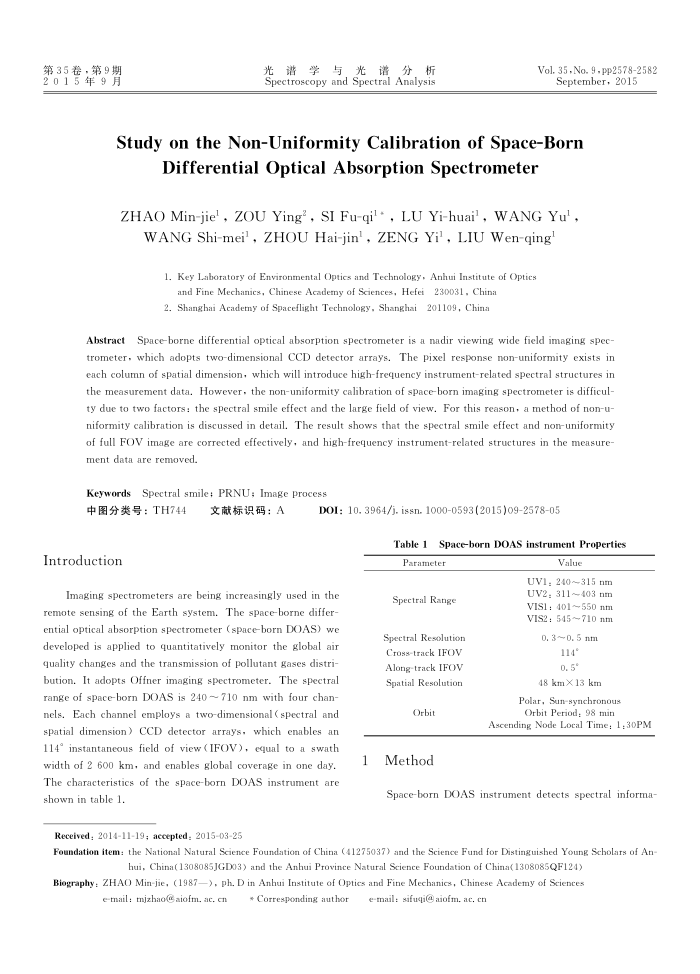星载痕量气体差分吸收光谱仪非均匀性校正研究
内容简介
 第35卷:第9期 2015年9月
第35卷:第9期 2015年9月谱学与光谱
营分
光
析
Spectroscopy and Spectral Analysis
Vol.35,No.9,pp2578-2582 September, 2015
StudyontheNon-UniformityCalibrationofSpace-Born
DifferentialOpticalAbsorption Spectrometer
ZHAOMin-jie',ZOUYing",SIFu-qil+,LUYi-huai',WANGYu',
WANG Shi-mei', ZHOU Hai-jin', ZENG Yi', LIU Wen-qing 1. Key Laboratory of Environmental Optics and Technology, Anhui Institute of Optics
and Fine Mechanics, Chinese Academy of Sciences, Hefei 230031, China 2. Shanghai Academy of Spaceflight Technology, Shanghai 201109, China
Abstract
Space-borne differential optical absorption spectrometer is a nadir viewing wide field imaging spec-
trometer, which adopts two-dimensional CCD detector arrays.
The pixel response non-uniformity exists in
each column of spatial dimension, which will introduce high-frequency instrument-related spectral structures in the measurement data. However, the non-uniformity calibration of space-born imaging spectrometer is difficul-ty due to two factors: the spectral smile effect and the large field of view. For this reason, a method of non-u-niformity calibration is discussed in detail. The result shows that the spectral smile effect and non-uniformity of full FOV image are corrected effectively, and high-frequency instrument-related structures in the measure-ment data are removed.
Keywords
Spectral smile; PRNU; Image process
中图分类号:TH744 Introduction
文献标识码:A
D0I: 10. 3964/j. issn. 1000-0593 (2015 )09257805
Table 1
Space-born DOAS instrument Properties
Parameter
Imaging spectrometers are being increasingly used in the
remote sensing of the Earth system. The space-borne differ-ential optical absorption spectrometer (space-born DOAS) we developed is applied to quantitatively monitor the global air quality changes and the transmission of pollutant gases distri-bution. It adopts Offner imaging spectrometer. The spectral range of space-born DOAS is 240 ~ 710 nm with four chan-nels. Each channel employs a two-dimensional ( spectral and
CCD detector arrays, which enables an
spatial dimension) (
114° instantaneous field of view (IFOV), equal to a swath width of 2 600 km, and enables global coverage in one day. The characteristics of the space-born DOAS instrument are shown in table 1.
Received: 2014-11-19; accepted: 2015-03-25
1
Spectral Range Spectral Resolution Cross-track IFOV Along-track IFOV Spatial Resolution
Orbit Method
Value
UV1: 240~315 nm UV2: 311~403 nm VIS1 : 401~550 nm VIS2 : 545~710 nm
0.3~0.5 nm 114° 0. 5*
48 kmX13 km
Polar, Sun-synchronous Orbit Period: 98 min
Ascending Node Loeal Time: 1 : 30PM
Space-born DOAS instrument detects spectral informa-
Foundation item: the National Natural Science Foundation of China (41275037) and the Science Fund for Distinguished Young Scholars of An
hui, China(1308085JGD03) and the Anhui Province Natural Science Foundation of China(1308085QF124)
Biography : ZHAO Min-jie, (1987—), ph, D in Anhui Institute of Opties and Fine Mechanics, Chinese Academy of Sciences
e-mail: mjzhao@aiofm. ac. cn
* Corresponding author
e-mail: sifuqi@aiofm. ac. cn